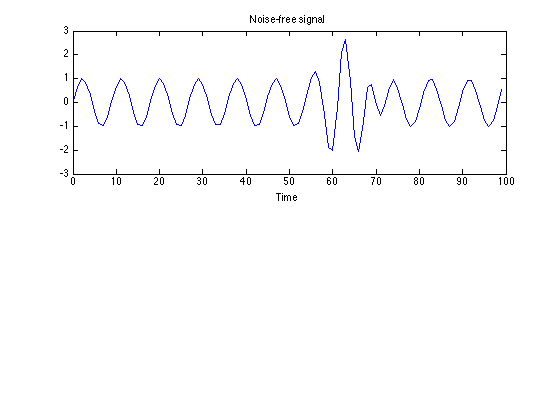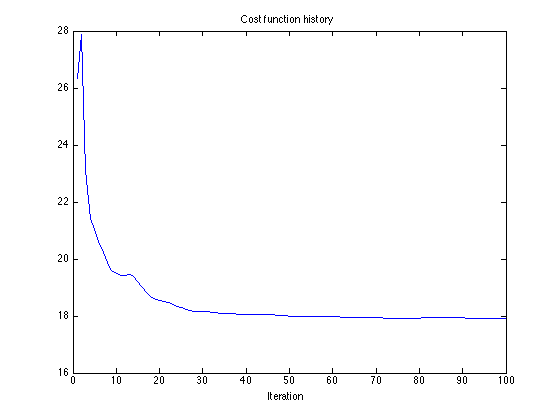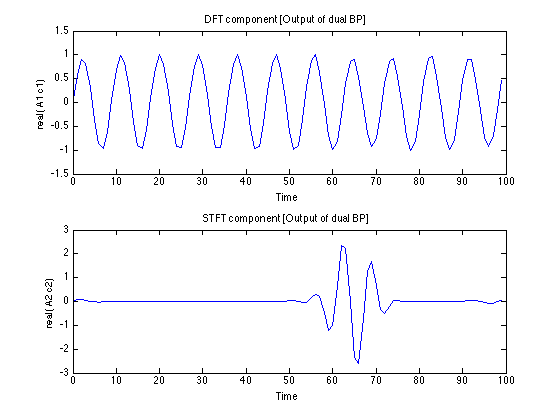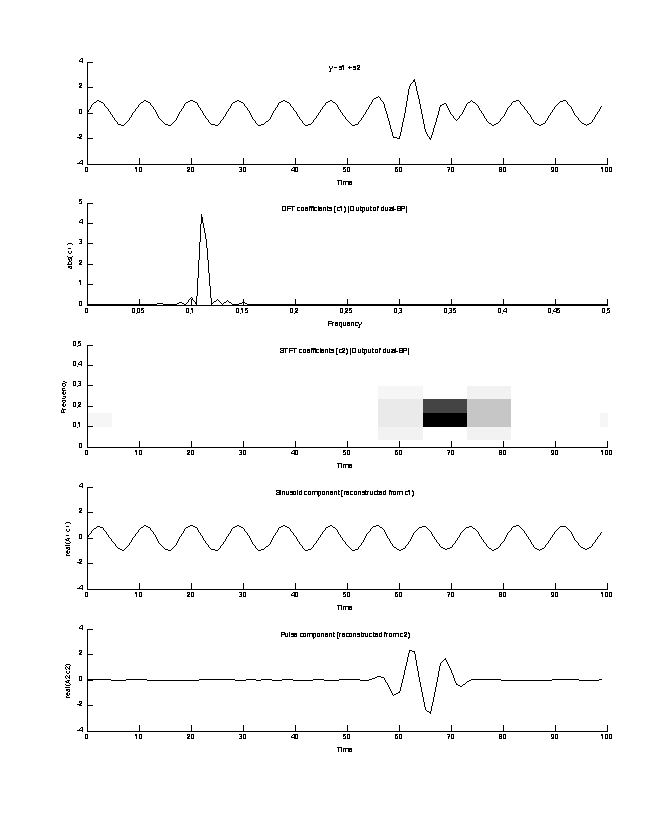Example: Dual basis pursuit (dual BP) with the DFT and STFT
Decompose a signal into two distinct signal components using dual basis pursuit (BP); i.e., MCA. In this example, the signal is the sum of a sinusoid and a pulse. The DFT and STFT are used for the two transforms.
Ivan Selesnick November, 2013
Contents
Start
clear
% close all
I = sqrt(-1);
Create data
Sinusoid + pulse
N = 100; % N : signal length n = 0:N-1; f1 = 0.112; s1 = sin(2*pi*f1*n); % s1 : complex sinusoid f2 = 0.15; K = 20; % K : duration of transient M = 55; % M : start-time of transient A = 3; s2 = zeros(size(n)); % s2 : transient s2(M+(1:K)) = A*sin(2*pi*f2*(1:K)) .* hamming(K)'; y = s1 + s2; % Add two components figure(1) clf subplot(2, 1, 1) plot(n, y) title('Noise-free signal') xlabel('Time')

Define transforms
K = 200; % K : length of DFT [A1, A1H, normA1] = MakeTransforms('DFT', N, K); R = 16; % R : frame length Nfft = 16; % Nfft : DFT length in STFT (Nfft >= R) [A2, A2H, normA2] = MakeTransforms('STFT', N, [R Nfft]);
Reconstruction error = 0.000000 Energy ratio = 1.000000 Reconstruction error = 0.000000 Energy ratio = 1.000000
Verify transform A1
Verify properties of transform A1 (A AH = I)
% Verify perfect reconstruction property of transform 1 (A1*A1H = I) c = A1H(y); err = y - A1(c); re = max(abs(err(:))); % should be zero fprintf('Reconstruction error = %f\n', re) % Verify Parseval energy identity E = sum(abs(y(:)).^2); E1 = sum(abs(c(:)).^2); % should be unity fprintf('Energy ratio = %f\n', E1/E)
Reconstruction error = 0.000000 Energy ratio = 1.000000
Verify transform A2
Verify properties of transform A2 (A AH = I)
% Verify perfect reconstruction property of transform 2 (A2*A2H = I) c = A2H(y); err = y - A2(c); re = max(abs(err(:))); % should be zero fprintf('Reconstruction error = %f\n', re) % Verify Parseval energy identity E = sum(abs(y(:)).^2); E1 = sum(abs(c(:)).^2); % should be unity fprintf('Energy ratio = %f\n', E1/E)
Reconstruction error = 0.000000 Energy ratio = 1.000000
Peform signal separation using dual BP
Use 'dualBP' (dual basis pursuit) to separate the signal into two components.
% Algorithm parameters theta = 0.5; % theta : trade-off parameter (0 < theta < 1) Nit = 100; % Nit : number of iterations mu = 1; % mu : ADMM parameter [x1, x2, c1, c2, cost] = dualBP(y, A1, A1H, A2, A2H, theta, mu, Nit); % Display cost function history figure(1) clf plot(cost) xlim([0 Nit]) title('Cost function history') xlabel('Iteration')

Display signal components
figure(1) clf subplot(2, 1, 1) plot(n, real(x1)) title('DFT component [Output of dual BP]'); xlabel('Time') ylabel('real( A1 c1)') subplot(2, 1, 2) plot(n, real(x2)) title('STFT component [Output of dual BP]'); xlabel('Time') ylabel('real( A2 c2)')

Display sparse component coefficients
f = (0:K-1)/K; % f : frequency axis tt = R/2 * ( (0:size(c2, 2)) - 1 ); % tt : time axis for STFT figure(2) clf subplot(2, 1, 1) plot(f, abs(c1)) title('Dual-BP DFT coefficients (c1, Output of dual BP)') xlabel('Frequency') subplot(2, 1, 2) imagesc(tt, [0 1], abs(c2)) xlim([0 N]) ylim([0 1]) axis xy title('Dual-BP STFT coefficients (c2, Output of dual BP)') xlabel('Time') ylabel('Frequency') cm = colormap(gray); % cm : colormap for STFT cm = cm(end:-1:1, :); colormap(cm)

Save figure to file
MyGraphPrefs('on') figure(4) clf ylim1 = 4*[-1 1]; subplot(5, 1, 1) line(n, y) mytitle('y = s1 + s2'); xlabel('Time') ylim(ylim1) % Display sparse component coefficients subplot(5, 1, 2) line(f, abs(c1), 'marker', '.') mytitle('DFT coefficients (c1) [Output of dual-BP]'); xlabel('Frequency') ylabel('abs( c1 )') xlim([0 0.5]) subplot(5, 1, 3) imagesc(tt, [0 1], abs(c2)) xlim([0 N]) ylim([0 0.5]) axis xy mytitle('STFT coefficients (c2) [Output of dual-BP]'); xlabel('Time') ylabel('Frequency') colormap(cm) box off % Dispaly signal components subplot(5, 1, 4) line(n, real(x1)) mytitle('Sinusoid component (reconstructed from c1)'); ylabel('real(A1 c1)') xlabel('Time') ylim(ylim1) subplot(5, 1, 5) line(n, real(x2)) ylim(ylim1) mytitle('Pulse component (reconstructed from c2)'); ylabel('real(A2 c2)') xlabel('Time') % print figure to pdf file orient tall print -dpdf figures/dualBP_example1 % print figure to eps file set(gcf, 'PaperPosition', [1 1 4.7 9]) print -deps figures_eps/dualBP_example1 MyGraphPrefs('off')
